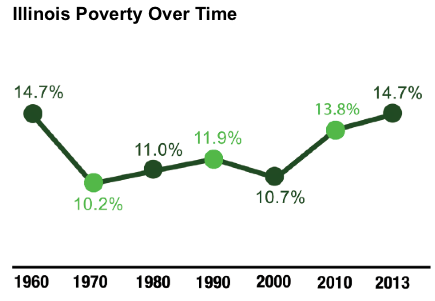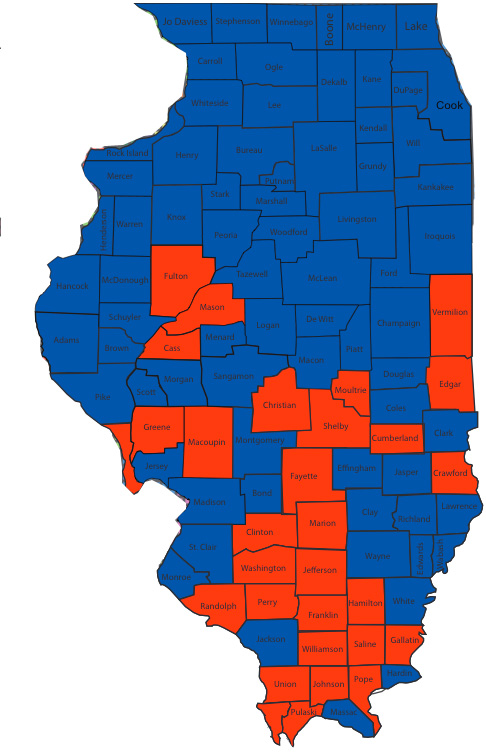The Heartland Alliance just released its annual report on poverty. The biggest news is bad: The state poverty rate, as of 2013, reached levels the state hasn't seen since 1960.

Here's how that poverty is distributed (deeper red means higher percentage of the population in poverty):
This reminded me of another map I saw recently.

That's from a recent report from John S. Jackson for SIU's Paul Simon Public Policy Institute, a postmortem on the 2014 governor's race. The blue counties are ones that Pat Quinn won. The red counties are ones that… Tio Hardiman won, in the 2014 Democratic primary.
I'd forgotten this, but as Jackson emphasizes, it was a really, really bad sign for Quinn. Hardiman, as you may recall, is from Chicago and had virtually no money or recognition, aside from his role as executive director of CeaseFire (a job that, at that point, he'd lost).
And he beat Quinn in 30 counties, winning 125,000 votes, over a quarter of those cast. "It was almost unheard of for a sitting governor to lose thirty counties in a Democratic primary against only token opposition," Jackson writes, fairly sizing up those losses as the result of protest votes against Quinn. "These results presaged the very steep hill he had to climb if he was going to win against a well-funded opponent in a general election."
As the report goes on to show, Quinn actually improved his vote total in the general election in 32 counties—almost all in central and western Illinois, none south of Effingham County, about two-thirds of the way down. Bruce Rauner improved over Bill Brady in the collar counties, the counties surrounding those, and all of far downstate Illinois. "Since downstate constituted 37 percent of the statewide two-party vote total in this election," Jackson writes, "Quinn's almost two-to-one loss in the 96 downstate counties was too deep a hole to climb out of in 2014."
Jackson attributes this in particular to Quinn shutting down prisons and other state offices—such as Tamms, in Alexander County, the only Illinois county with a poverty rate north of 30 percent in 2013. Jackson County had a 29.5 percent poverty rate in 2013, and it saw two major closures. Government is a big employer downstate, so it was a huge political risk for Quinn. And the SIU report makes a good case that he paid for it.
But another thing is clear from the report—Rauner's base of support, among the GOP, lies north of Champaign. And not just in the collar counties, but uninterrupted victories from Lake to Jo Daviess and Kankakee to Mercer, running across the state (save for Ogle and Lee in north-central Illinois). By contrast, Kirk Dillard surpassed Rauner in central and downstate Illinois in the primary.
Which presents yet another challenge for Rauner, either for a second term or to leave his Republican successor a path to victory—reining in spending while maintaining support in an area with high poverty that's already borne significant cuts, and has shown a willingness to express its displeasure at the ballot box.



